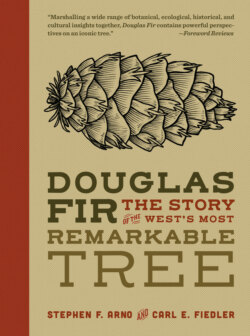Douglas Fir

Реклама. ООО «ЛитРес», ИНН: 7719571260.
Оглавление
Stephen F. Arno. Douglas Fir
PRAISE FOR DOUGLAS-FIR
CONTENTS
INTRODUCTION: Nature’s All-Purpose Tree
CHAPTER 1. Unlocking Douglas-Fir’s Secrets
CHAPTER 2. Coastal Giants
CHAPTER 3. Inland Douglas-Fir: Fixture of the Mountain West
CHAPTER 4. The Tree That Built an Empire
CHAPTER 5. Douglas-Fir Use Through the Ages
CHAPTER 6. Different Forests, Different Fires
CHAPTER 7. What Future Awaits Douglas-Fir Forests?
ACKNOWLEDGMENTS
A VISITOR’S GUIDE TO NOTABLE DOUGLAS-FIRS
REFERENCES
INDEX
ABOUT THE AUTHORS
Отрывок из книги
“Arno and Fiedler have crafted an insightful and engaging paean to the Pacific Northwest’s most important tree. This is a book for anyone who wants to understand not only the ecological story of Douglas-fir but also how these majestic trees shaped the economic story of Puget Sound and the entire region.”
—David B. Williams, author, Too High and Too Steep: Reshaping Seattle’s Topography
.....
I moved to the inland Northwest in 1963 and then to the Northern Rockies for college and a career in forestry. Forests in these regions were often dominated by other long-lived trees, particularly ponderosa pine, western larch, and western white pine, each with its own unique majesty. Interestingly, inland Douglas-fir nearly always grew in these forests and often regenerated in abundance, filling the understory with saplings and young pole-size trees. Douglas-fir was clearly poised to dominate much of the inland forest.
In 1971, soon after completing a PhD in forest ecology, and keeping mum about that to coworkers in my first job in a sawmill and my second job as a timber-sale forester, I was blessed to be chosen as part of a small research team whose goal was to document examples of the original forest types in the Northern Rockies. We inventoried all trees and flowering plants in 1482 large plots within mature forest stands in Montana and described ecological conditions such as soils, geology, wildlife use, and evidence of past fires. It turned out that Douglas-fir occupied 998 of these stands—a far higher frequency than any other tree or plant. A similar inventory of forests in central Idaho accumulated a sample of 761 stands, 506 of which contained Douglas-fir, again the most frequently recorded plant. Douglas-fir is also widely present and often a dominant tree in forests from central British Columbia to central California and south through the Rockies to the high mountains of southern Arizona. And in all of these regions this species is often one of the biggest trees.
.....